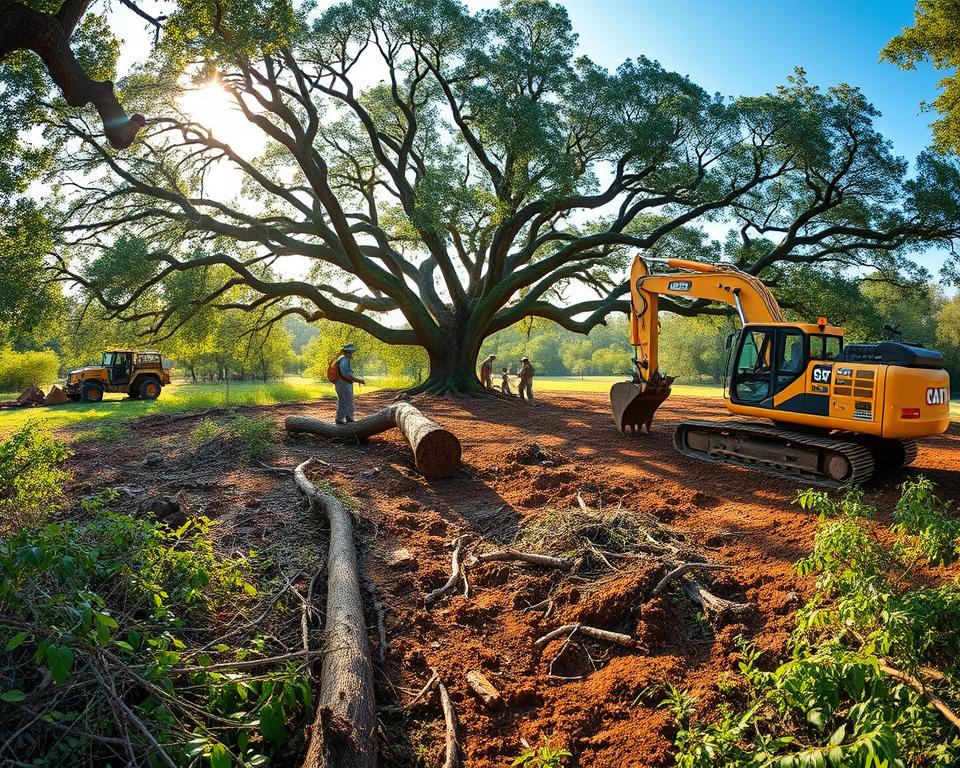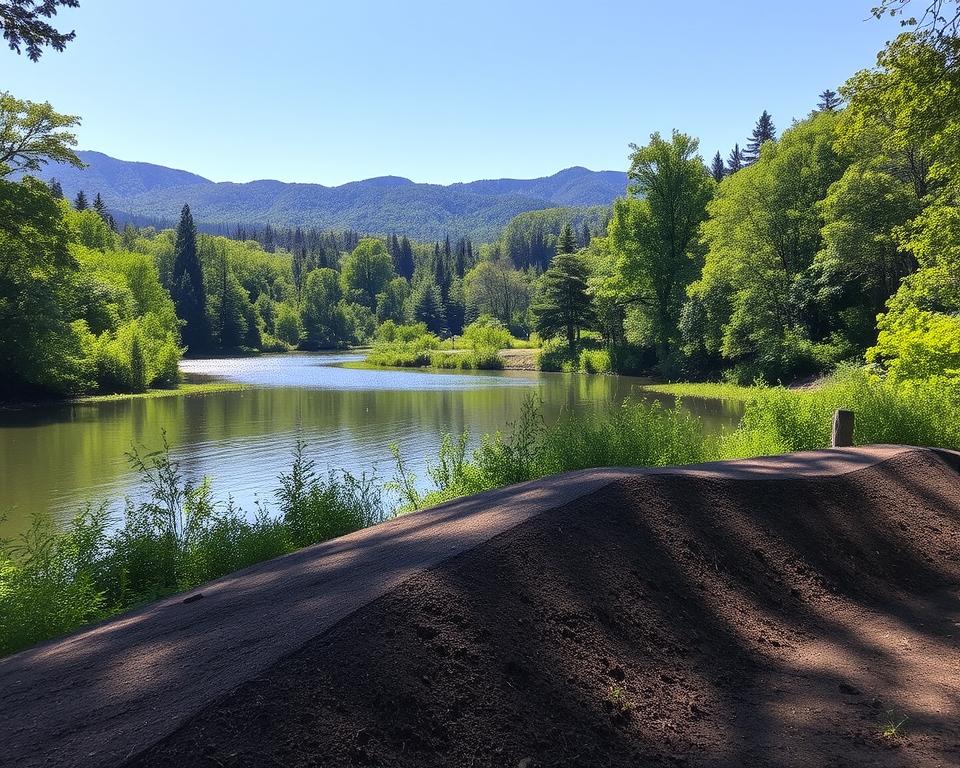Land Clearing in Proximity to Water Sources: Best Methods
You may not know this, but nearly seventy percent of the global freshwater resources suffer threats from farm runoff and Land Clearing? This eye-opening figure calls attention to the critical requirement for responsible land management, essential during water source Land Clearing. Ensuring ecological accountability is key to upholding ecosystem equilibrium and preserving aquatic purity and animal habitats. With increasing resource demands from communities, adopting sustainable land management practices is indispensable. This approach promotes project success while mitigating soil erosion and minimizing pollution threats in aquatic ecosystems – land clearing services near me.
Critical Summaries
- Eco-friendly land management is essential for protecting water quality.
- Implementing best practices can prevent soil erosion and habitat loss.
- Awareness of environmental impacts is critical for responsible Land Clearing.
- Thoughtful planning boosts project success while preserving ecosystems.
- Utilizing effective techniques promotes biodiversity in aquatic landscapes.
Comprehending Sustainable Land Clearing’s Importance
Land Clearing involves more than simply uprooting vegetation. It has ecological effects of Land Clearing that can harm areas around it, mainly near water. Traditional methods often cause soil erosion, disrupt habitats, and can pollute water. Recognizing these impacts is essential for embracing superior land management.
Environmental Consequences of Typical Land Clearing
Standard Land Clearing methods can cause many environmental issues. Soil erosion happens when vegetation is lost, degrading soil and causing sediment runoff into water. This runoff can pollute water bodies, harming aquatic ecosystems. Furthermore, it endangers local fauna and upsets ecological equilibrium.
Sustainable Alternatives for Land Management
Adopting sustainable land management practices offers a solution to traditional clearing’s problems. Selective clearing, where specific plants are removed, preserves ecosystem balance. Applying erosion control tactics, including cover crops, fortifies soils and maintains water quality. Emphasizing indigenous vegetation bolsters wildlife and fosters ecological well-being.
Essential Best Practices for Land Clearing
Effective Land Clearing begins with thorough comprehension of environmental aspects. Evaluating environmental aims is key for ensuring effective, sustainable clearing. Setting distinct goals enables landowners to harmonize environmental conservation and development.

Assessing Your Environmental Goals
Before a clearing project, one must appraise environmental goals. This process includes analyzing the ecosystem and potential clearing effects on wildlife, soil, and water. Clarifying individual goals supports designing tactics to shield local habitats and watersheds.
Choosing the Right Time for Clearing
The timing of Land Clearing is key to its success. Winter and early spring are ideal, as the ground is frozen, reducing soil disturbance and erosion risks. Knowing when to avoid clearing can lead to healthier landscapes and lower environmental impact.
Evaluating Local Regulations and Permit Requirements
Adhering to local Land Clearing rules is vital for project success. Knowing permit prerequisites helps prevent legal troubles or penalties. It’s wise to check local ordinances, even near protected areas, to avoid environmental disasters from unapproved clearing.
Land Clearing By Water Sources: Top Techniques
Effective Land Clearing practices around water sources focus on protecting sensitive areas while ensuring ecological balance. A thorough approach involves identifying regions that require special care and implementing appropriate erosion control methods. These steps are critical for preserving biodiversity and maintaining water quality.
Recognizing Zones Requiring Protection
Prior to Land Clearing, evaluating the terrain for sensitive sites—like wetlands and riparian strips—is crucial. These ecological hotspots filter pollutants and offer habitats for diverse species. By accurately mapping these zones, land managers can plan protective strategies before and after clearing.
Applying Erosion Control Techniques
After locating sensitive zones, one should apply robust erosion control to reduce sediment flow into nearby waters. Techniques such as silt fencing, natural buffers, and planting cover crops contribute significantly to maintaining water quality. Emphasizing sustainable Land Clearing practices in combination with these erosion control measures fosters a healthier ecosystem around water resources. These efforts benefit ecosystems and nearby communities alike.
Comparing Mechanical and Manual Clearing
Selecting mechanical or manual clearing is important. Each approach offers pros and cons regarding environmental impact and process efficiency. Recognizing these variations enables informed decision-making aligned with management aims.
Pros and Cons of Mechanical Clearing
Mechanical clearing uses heavy equipment for rapid removal of vegetation and debris. It speeds project timelines and reduces manual labor requirements. Yet, machinery use can cause significant soil disturbance, compaction, and damage to ecosystems.
- Pros: Efficiency in clearing large areas.
- Lower manual labor expenses.
- Capability to operate on rough landscapes.
- Cons: Increased environmental impact.
- Potential for soil erosion.
- Potential habitat damage.
Benefits of Manual and Selective Clearing
Manual, selective clearing prioritizes ecological preservation. Using trained workers, targeted removal reduces soil disruption and safeguards vegetation. This method is ideal when maintaining biodiversity and ecological health are key.
- Advantages: Conservation of indigenous plants.
- Reduced soil disturbance and erosion.
- Strengthened habitat protection for fauna.
Wetland Clearing Techniques
Wetland ecosystems are remarkable environments that play a vital role in maintaining ecological balance. They purify water, mitigate flooding, and serve as habitats for diverse life forms. Understanding these ecosystems is key to responsible wetland clearing practices. The objective is to lessen disruptions and maintain these aquatic habitats.
Grasping Wetland Ecology
Wetland ecosystems are characterized by their unique hydrology, soil types, and vegetation. They are transitional areas between land and water, hosting diverse fauna. These ecosystems are essential for water quality regulation, providing natural filtration processes that remove pollutants. Protecting these zones supports biodiversity and strengthens ecosystem resilience.
Techniques for Responsible Wetland Clearing
Responsible wetland clearing requires careful planning and execution. Sustainable methods can reduce the adverse effects of clearing. Widely employed strategies include:
- Staging Operations: Conduct clearing in phases to minimize ecological disruption, allowing time for wildlife to adapt.
- Targeted Clearing: Remove only specific vegetation types, preserving critical species for habitat stability.
- Encouraging Regrowth: Introduce practices that encourage natural vegetation regrowth after clearing, maintaining ecosystem functions.
- Establishing Buffer Areas: Establish buffer areas around sensitive wetland sections to protect aquatic habitats from disturbances.
Implementing these techniques confirms that wetland clearing upholds ecosystem services and curbs habitat destruction.
Safeguarding Riparian Reserves in Clearing
Riparian reserves are crucial for healthy water ecosystems. Positioned beside rivers and streams, these zones function as protective buffers. They protect water quality and boost biodiversity. With best practices, managers avoid erosion, conserve wildlife habitats, and uphold waterway ecology.
Importance of Riparian Buffers in Aquatic Ecosystems
Riparian buffers support aquatic ecosystem health. They remove contaminants, reinforce banks, and host diverse species. These buffers act as protective barriers, reducing the impact of human activities on water bodies. Preserving these zones boosts water quality and supports fish and aquatic life, enhancing ecosystem resilience.
Riparian Zone Management Tips
Effective riparian reserve maintenance involves these best practices:
- Avoid construction within buffer strips to minimize disturbance.
- Use native vegetation to stabilize banks and prevent erosion.
- Establish a diverse plant community to enhance habitat complexity and support wildlife.
- Manage invasive species to protect native plants and maintain ecosystem stability.
- Regularly assess soil health and water quality to guide management efforts.
Importance of Aquatic Land Clearing Strategies
Aquatic land clearing strategies are vital for ecological balance and healthy water systems. Effective water quality management during clearing reduces pollution risks and promotes sustainability. These strategies prevent sediment runoff and improve aquatic ecosystem health.
Water Quality and Sediment Management Tactics
Ensuring water quality begins by assessing nearby water holdings. Land clearing near these areas must prevent sedimentation, which harms water quality and aquatic life. Strategies include:
- Establishing buffer zones to filter pollutants
- Using sediment traps and barriers to minimize runoff
- Selecting clearing times to coincide with low water levels
These practices shield water quality and sustain ecosystem health. Retained vegetation helps control sediments and cycle nutrients, resulting in healthier water systems.
Aquatic Biodiversity Protection
Maintaining biodiversity in aquatic landscapes is key for resilient ecosystems. Clearing near water must safeguard indigenous species crucial to habitats. Steps to boost biodiversity include:
- Conserving critical habitats during clearing processes
- Implementing phased clearing to allow wildlife adaptation
- Restoring natural vegetation post-clearing to enhance habitat
Using these approaches helps land managers cultivate biodiversity in aquatic zones. The result is healthier, more flexible ecosystems. Such measures defend water quality and encourage sustainable land management.
Considerations for Stream Bank Clearing
Clearing stream banks poses unique challenges, requiring attention to ecological impacts and regulations. It’s essential to ensure the process respects riverbank considerations to preserve water sources’ ecological balance. Issues like erosion, habitat disruption, and water quality decline require strategic solutions during clearing.
Stream Bank Clearing Challenges
Clearing stream banks encounters multiple obstacles. Erosion poses significant risks, leading to soil depletion and declining water quality. Habitat disruption endangers fauna dependent on riparian habitats. Without natural vegetation, stormwater runoff increases, leading to sedimentation in waterways. These challenges underline the necessity of strategic stream bank management.
Combatting Erosion and Promoting Healthy Flora
Mitigating erosion is key for stream bank clearing. Using indigenous vegetation fortifies banks. Root systems reduce erosion, promoting a sustainable habitat for local plants and wildlife. Periodic reviews in clearing guarantee efficacy and preserve riverbank ecology. Robust vegetation aids land management and preserves ecological integrity.
Conclusion
Following best practices in water source Land Clearing is critical to ecosystem well-being. Stakeholders must focus on sustainable land management. This strategy achieves project aims while safeguarding the environment. Careful planning and execution ensure Land Clearing operations safeguard aquatic ecosystems and preserve biodiversity.
Identifying sensitive areas and using erosion control measures are key steps. Combining mechanical and manual methods supports landowners and contractors in responsible land management. Sustainable practices foster harmony between development and nature. This ensures water sources and adjacent landscapes remain vibrant and resilient.
Sustainable land management demands collective commitment. Each step in Land Clearing affects watershed integrity. By adopting eco-friendly methods, we enable a future where farming and environments thrive together.
